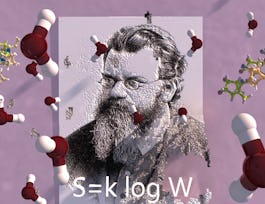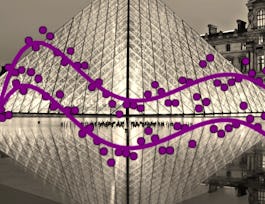In this course you will learn a whole lot of modern physics (classical and quantum) from basic computer programs that you will download, generalize, or write from scratch, discuss, and then hand in. Join in if you are curious (but not necessarily knowledgeable) about algorithms, and about the deep insights into science that you can obtain by the algorithmic approach.


Statistical Mechanics: Algorithms and Computations
Taught in English
Some content may not be translated
36,675 already enrolled
(262 reviews)
Details to know
9 quizzes
See how employees at top companies are mastering in-demand skills

There are 10 modules in this course
Dear students, welcome to the first week of Statistical Mechanics: Algorithms and Computations! <br> Here are a few details about the structure of the course: For each week, a lecture and a tutorial videos will be presented, together with a downloadable copy of all the relevant python programs mentioned in the videos. Some in-video questions and practice quizzes will help you to review the material, with no effect on the final grade. A mandatory peer-graded assignment is also present, for weeks from 1 to 9, and it will expand on the lectures' topics, letting you reach a deeper understanding. The nine peer-graded assignments will make up for 50% of the grade, while the other half will come from a final exam, after the last lecture. <br> In this first week, we will learn about algorithms by playing with a pebble on the Monte Carlo beach and at the Monaco heliport. In the tutorial we will use the 3x3 pebble game to understand the essential concepts of Monte Carlo techniques (detailed balance, irreducibility, and a-periodicity), and meet the celebrated Metropolis algorithm. Finally, the homework session will let you understand some useful aspects of Markov-chain Monte Carlo, related to convergence and error estimations.
What's included
3 videos2 readings1 quiz1 peer review
In Week 2, you will get in touch with the hard-disk model, which was first simulated by Molecular Dynamics in the 1950's. We will describe the difference between direct sampling and Markov-chain sampling, and also study the connection of Monte Carlo and Molecular Dynamics algorithms, that is, the interface between Newtonian mechanics and statistical mechanics. The tutorial includes classical concepts from statistical physics (partition function, virial expansion, ...), and the homework session will show that the equiprobability principle might be more subtle than expected.
What's included
3 videos1 reading1 quiz1 peer review
After the hard disks of Week 2, in Week 3 we switch to clothe-pins aligned on a washing line. This is a great model to learn about the entropic interactions, coming only from statistical-mechanics considerations. In the tutorial you will see an example of a typical situation: Having an exact solution often corresponds to finding a perfect algorithm to sample configurations. Finally, in the homework session we will go back to hard disks, and get a simple evidence of the transition between a liquid and a solid, for a two-dimensional system.
What's included
3 videos2 readings1 quiz1 peer review
In Week 4 we will deepen our understanding of sampling, and its connection with integration, and this will allow us to introduce another pillar of statistical mechanics (after the equiprobability principle): the Maxwell and Boltzmann distributions of velocities and energies. In the homework session, we will push the limits of sampling until we can compute the integral of a sphere... in 200 dimensions!
What's included
3 videos1 reading1 quiz1 peer review
Week 5 is the first episode of a three-weeks journey through quantum statistical mechanics. We will start by learning about density matrices and path integrals, fascinating tools to study quantum systems. In many cases, the Trotter approximation will be useful to consider non-trivial systems, and also to follow the time evolution of a system. All these topics, including the matrix-squaring technique, will be reviewed in detail in the homework session, where you will also study the anharmonic potential. <br> Note that previous knowledge of quantum mechanics is not really necessary to go through the next three weeks. Follow us in our journey through algorithms and physics, and don't forget to ask on the forum if you have any doubt!
What's included
3 videos1 reading1 quiz1 peer review
In Week 6, the second quantum week, we will introduce the properties of bosons, indistinguishable particles with peculiar statistics. At the same time, we will also go further by learning a powerful sampling algorithm, the Lévy construction, and in the homework session you will thoroughly compare it with standard sampling techniques.
What's included
3 videos1 reading1 quiz1 peer review
At the end of our quantum journey, in Week 7, we discuss the Bose-Einstein condensation phenomenon, theoretically predicted in the 1920's and observed in the 1990's in experiments with ultracold atoms. In the path-integral framework, an elegant description of this phenomenon is in term of permutation cycles, which will also lead to a great sampling algorithm, to be discussed in the homework session.
What's included
3 videos1 reading1 quiz1 peer review
In Week 8 we come back to classical physics, and in particular to the Ising model, which captures the essential physics of a set of magnetic spins. This is also a fundamental model for the development of sampling algorithms, and we will see different approaches at work: A local algorithm, the very efficient cluster algorithms, the heat-bath algorithm and its connection with coupling. All of these will be revisited in the homework session, where you will get a precise control over the transition between ordered and disordered states.
What's included
3 videos1 reading1 quiz1 peer review
Continuing with simple models for spins, in Week 9 we start by learning about a dynamic Monte Carlo algorithm which runs faster than the clock. This is easily devised for a single-spin system, and can also be generalized to the full Ising model from Week 8. In the tutorial we move towards the simulated-annealing technique, a physics-inspired optimization method with a very broad applicability. You will also revisit this in the homework session, and apply it to the sphere-packing and traveling-salesman problems.
What's included
3 videos1 reading1 peer review
The lecture of Week 10 includes the alpha and the omega of our course. First we repeat the experiment of Buffon's needle, already performed in the 18th century, and then we touch the sophisticated theory of Lévy stable distributions, and their connection with the central limit theorem. In the tutorial there will be time for a review of the entire course material, and then a little party is due, to celebrate the end of the course! <br> (There is no homework session for Week 10, but don't forget that the final exam is still there!)
What's included
2 videos1 reading1 quiz
Instructor

Offered by
Recommended if you're interested in Physics and Astronomy

Carnegie Mellon University

INSEAD

École normale supérieure

Amazon Web Services
Why people choose Coursera for their career




Learner reviews
Showing 3 of 262
262 reviews
- 5 stars
85.87%
- 4 stars
11.83%
- 3 stars
1.14%
- 2 stars
0.38%
- 1 star
0.76%

Open new doors with Coursera Plus
Unlimited access to 7,000+ world-class courses, hands-on projects, and job-ready certificate programs - all included in your subscription
Advance your career with an online degree
Earn a degree from world-class universities - 100% online
Join over 3,400 global companies that choose Coursera for Business
Upskill your employees to excel in the digital economy
Frequently asked questions
Access to lectures and assignments depends on your type of enrollment. If you take a course in audit mode, you will be able to see most course materials for free. To access graded assignments and to earn a Certificate, you will need to purchase the Certificate experience, during or after your audit. If you don't see the audit option:
The course may not offer an audit option. You can try a Free Trial instead, or apply for Financial Aid.
The course may offer 'Full Course, No Certificate' instead. This option lets you see all course materials, submit required assessments, and get a final grade. This also means that you will not be able to purchase a Certificate experience.

